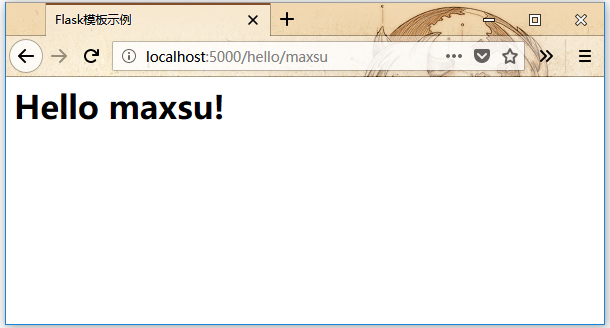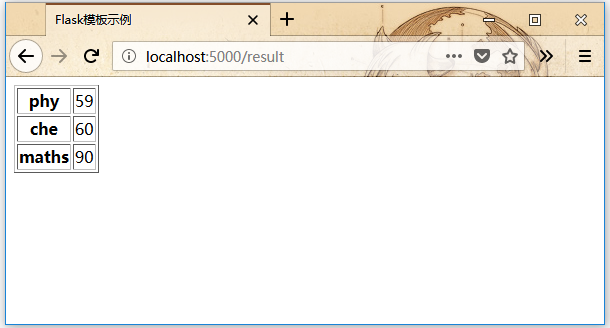Flask模板
Flask可以以HTML形式返回系結到某個URL的函式的輸出。 例如,在以下指令碼中,hello()函式將使用附加的<h1>標記呈現‘Hello World’ 。
from flask import Flask
app = Flask(__name__)
@app.route('/')
def index():
return '<html><body><h1>'Hello World'</h1></body></html>'
if __name__ == '__main__':
app.run(debug = True)
但是,從Python程式碼生成HTML內容非常麻煩,尤其是在需要放置可變資料和Python語言元素(如條件或迴圈)時。經常需要跳脫HTML程式碼。
它可以利用Jinja2模板引擎技術,而不需要從函式返回寫死HTML。如下程式碼所示,可以通過render_template()函式渲染HTML檔案。
from flask import Flask
app = Flask(__name__)
@app.route('/')
def index():
return render_template(‘hello.html’)
if __name__ == '__main__':
app.run(debug = True)
Flask將嘗試在該指令碼所在的同一檔案夾中查詢templates檔案夾中的HTML檔案。使用模板的應用程式目錄結構如下所示 -
app.py
hello.py
templates
hello.html
register.html
....
術語「Web模板系統」是指設計一個HTML指令碼,其中可以動態插入變數資料。 Web模板系統由模板引擎,某種資料源和模板處理器組成。
Flask使用jinga2模板引擎。 Web模板包含用於變數和表示式(這些情況下為Python表示式)的HTML語法散布預留位置,這些變數和表示式在模板呈現時被替換為值。
以下程式碼在模板(templates)檔案夾中儲存為:hello.html。
<html>
<head>
<meta http-equiv="Content-Type" content="text/html; charset=utf-8" />
<title>Flask HTTP請求方法處理</title>
</head>
<body>
<h1>Hello {{ name }}!</h1>
</body>
</html>
接下來,將以下程式碼儲存在app.py檔案中,並從Python shell執行 -
from flask import Flask, render_template
app = Flask(__name__)
@app.route('/hello/<user>')
def hello_name(user):
return render_template('hello.html', name = user)
if __name__ == '__main__':
app.run(debug = True)
在開發伺服器開始執行時,開啟瀏覽器並輸入URL為 - http://localhost:5000/hello/maxsu
URL的可變部分插入{{name}}預留位置處。

Jinja2模板引擎使用以下分隔符來從HTML跳脫。
{% ... %}用於多行語句{{ ... }}用於將表示式列印輸出到模板{# ... #}用於未包含在模板輸出中的註釋# ... ##用於單行語句
在以下範例中,演示了在模板中使用條件語句。 hello()函式的URL規則接受整數引數。 它傳遞給hello.html模板。 在它裡面,收到的數位(標記)的值被比較(大於或小於50),因此在HTML執行了有條件渲染輸出。
Python指令碼如下 -
from flask import Flask, render_template
app = Flask(__name__)
@app.route('/hello/<int:score>')
def hello_name(score):
return render_template('hello.html', marks = score)
if __name__ == '__main__':
app.run(debug = True)
模板檔案:hello.html 的HTML模板指令碼如下 -
<html>
<head>
<meta http-equiv="Content-Type" content="text/html; charset=utf-8" />
<title>Flask模板範例</title>
</head>
<body>
{% if marks>50 %}
<h1> 通過考試!</h1>
{% else %}
<h1>未通過考試!</h1>
{% endif %}
</body>
</html>
請注意,條件語句if-else和endif包含在分隔符{%..。%}中。
執行Python指令碼並存取URL=> http://localhost/hello/60 ,然後存取 http://localhost/hello/59,以有條件地檢視HTML輸出。
Python迴圈結構也可以在模板內部使用。 在以下指令碼中,當在瀏覽器中開啟URL => http:// localhost:5000/result時,result()函式將字典物件傳送到模板檔案:results.html 。
result.html 的模板部分採用for迴圈將字典物件result{}的鍵和值對呈現為HTML表格的單元格。
從Python shell執行以下程式碼。
from flask import Flask, render_template
app = Flask(__name__)
@app.route('/result')
def result():
dict = {'phy':59,'che':60,'maths':90}
return render_template('result.html', result = dict)
if __name__ == '__main__':
app.run(debug = True)
將以下HTML指令碼儲存為模板檔案夾(templates)中的模板檔案:result.html 。
<html>
<head>
<meta http-equiv="Content-Type" content="text/html; charset=utf-8" />
<title>Flask模板範例</title>
</head>
<body>
<table border = 1>
{% for key, value in result.items() %}
<tr>
<th> {{ key }} </th>
<td> {{ value }} </td>
</tr>
{% endfor %}
</table>
</body>
</html>
在這裡,與For迴圈相對應的Python語句包含在{%...%}中,而表示式鍵和值放在{{}}中。
開發開始執行後,在瀏覽器中開啟http://localhost:5000/result以獲得以下輸出。
